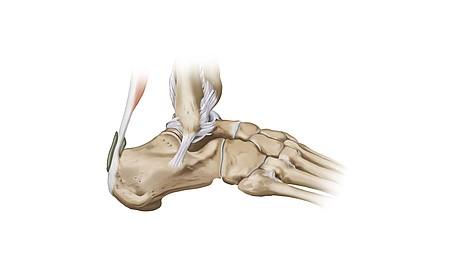What is a sprain (distortion)?
Sprains are one of the most common painful sports injuries. It occurs when the joint capsule or the surrounding ligaments and muscles are excessively overstretched due to an unfavourable movement. This often leads to bleeding, swelling and small cracks in these structures.
Usually, treating sprains is uncomplicated. The pain usually subsides by itself, and the joint is fully resilient again – as soon as the sprain has healed up, and there are no more serious concomitant injuries.
In some cases, ligament, capsule or muscle injuries caused by sprains can lead to chronic joint instability. To avoid this, you should consider the following aspects.
Chronic joint instability
Chronic ligament instabilities can lead to severe wear and tear of the cartilage in the joint and to arthrosis. Therefore, even in the case of an apparently harmless sprain, a visit to an orthopaedist or sports doctor is recommended.
Causes – how do sprains develop?
In sprains, the physiological, i.e., the natural range of motion of a joint is exceeded due to external forces. This excessive movement within a joint – usually triggered suddenly – can cause injuries to the structures stabilising the joint.
Symptoms and signs – how to recognise sprains?
These are the signs of sprain:
- Pain
- Joint swelling
- Bruise
- Limited range of movement at the joint
If you experience these signs, you should consult a GP, sports doctor or orthopaedist to rule out more serious injuries such as torn ligaments or broken bones.
Risk factors for sprains

Some people have weak ligaments and tend to get sprains more than others. People with hollow foot, delayed muscle reaction time or muscle weakness are also more frequently affected.
Sprains can happen quickly, especially during exercise: Sprains often occur when playing basketball, jogging on uneven ground or playing football. Thumb and finger joints, for example, can be jammed when playing handball, volleyball or skiing.
Another classic is the sprained toe: when you walk barefoot and get caught on a piece of furniture or a half-opened door.
Prevention of sports injuries
If your ankle joint is unstable (possibly due to previous injuries or a loose ligamentous apparatus), sprains due to twisting may occur more easily.
A bandage can be used here (for example, from the range of medi Levamed ankle bandages) .
In case of corresponding discomforts in the wrist, products from the medi Manumed range can be used as support.
Another tip: Always make sure that your footwear is sturdy and suitable for its purpose. This applies to sports and leisure activities as well as in everyday life.
Sprains - what to do? Therapy according to the RICE rule
If the ankle joint or any other part of the body is sprained, the RICE rule is a good guide for initial measures:
R = Rest
I = Ice (cooling)
C = Compression
E = Elevation
Rest: When a sprain occurs, you should stop your physical activity immediately. The affected part of the body should be immobilised and no longer be put under strain.
Ice: Start cooling the affected joint immediately. This counteracts the swelling. In addition, cooling generally contributes to acute pain relief.
Compression: An elastic bandage wrapped around the joint with slight tension brings the necessary compression to the injured area. During the acute phase, it is best to combine the pressure dressing with a cool-pack, and later with a pain-relieving ointment. If medically necessary, the doctor can also prescribe a bandage made of compressive fabric to support the healing process. Depending on the severity of the injury, the doctor can include an orthosis (splint) in the therapy.
Elevation: The last step is to elevate the affected limbs.
Quick help for ankle sprains: effective exercises to do at home
Our targeted exercises for sprains not only provide noticeable relief, but also promote faster recovery. The exercises aim to strengthen the muscles around the sprained region. Targeted movements improve blood circulation, reduce swelling and promote flexibility in your ankle joint.
medi products for sprains
The rigid half shells of the ankle brace M.step* provide excellent stabilisation during pronation and supination movements (turning of the foot).
Find out more about M.step orthosis by medi here.
The modular design of the Levamed stabili-tri** supports functional treatment and can be adapted to the particular phase of healing (stage-adapted) for safe and reliable treatment and mobilisation of the patient. The joint is stabilised and relieved by the interaction between the compressive knitted fabric, inelastic stabilising element and additional strap.
Find out more about Levamed stabili-tri here.
The human body
Product tip
Product tip
Remarks:
* Ankle brace for stabilisation in one plane.
** Ankle brace for mobilisation in a defined position, parts can be removed.




